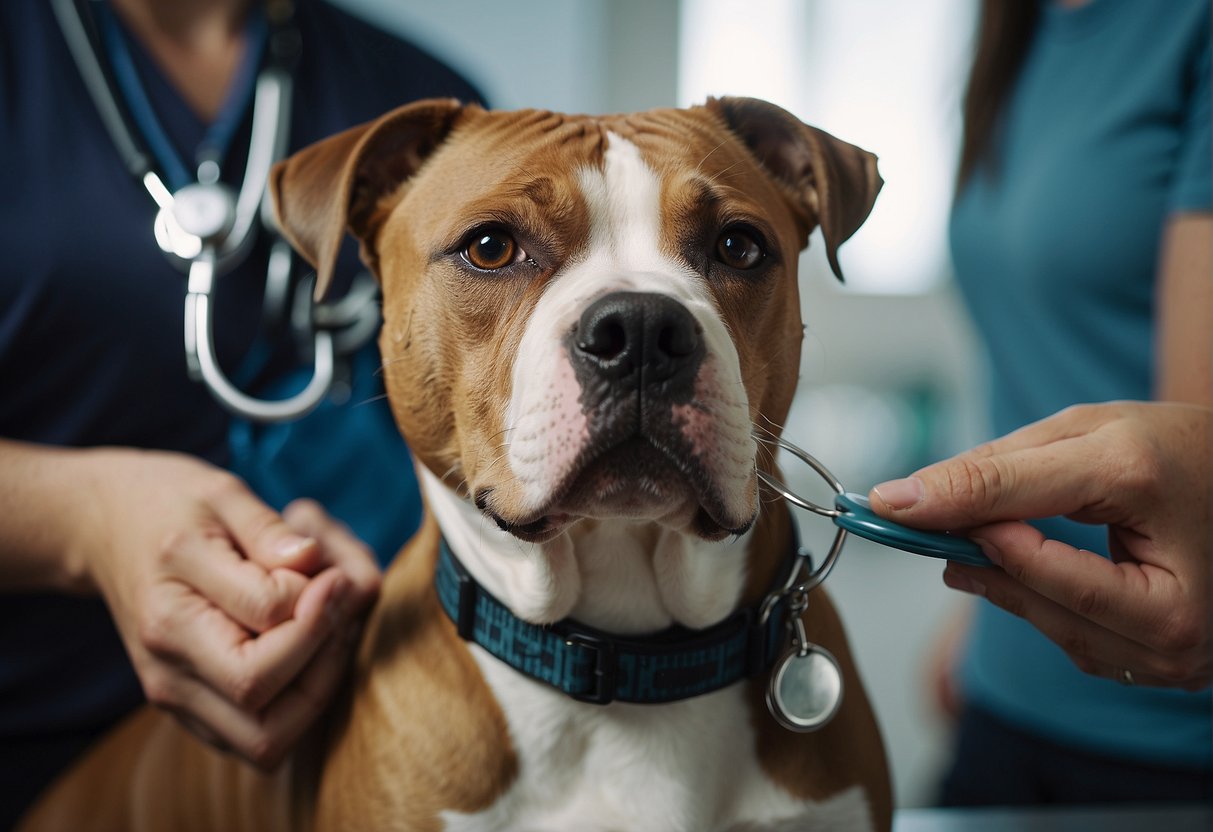The American Staffordshire Terrier, affectionately known as the AmStaff, is a breed celebrated for its strength, intelligence, and affectionate nature.
As sturdy and energetic as these dogs are, they’re not impervious to health issues, particularly joint problems.
Owners of these terriers will find that proactive home care is vital in managing their pet’s comfort and mobility.

Caring for an AmStaff with joint issues involves a multifaceted approach that ranges from diet management to gentle exercise routines.
It’s important to balance activity with rest, ensuring these muscular terriers maintain their joint health without exacerbating any existing conditions.
A considered plan can help mitigate the risks of more serious complications, such as arthritis, which is not uncommon in the breed.
Understanding the common health challenges faced by American Staffordshire Terriers, especially concerning joint health, empowers owners to provide the best possible care.
With the right knowledge and resources, managing an AmStaff’s joint issues at home can be both effective and rewarding, ensuring a good quality of life for these loving and loyal companions.
Understanding Joint Problems in American Staffordshire Terriers

American Staffordshire Terriers, known for their strength and athleticism, can unfortunately be prone to joint problems, including conditions like hip and elbow dysplasia, which can lead to arthritis.
It’s essential for owners to recognize the symptoms early and understand the hereditary nature of these conditions for effective treatment.
Identifying Symptoms of Joint Issues
Owners should be vigilant for signs of joint pain in their Amstaffs. Symptoms to watch for include:
- Lameness or reluctance to move
- Difficulty standing up or lying down
- Audible creaking of the joints
- Swelling around the joints
- Reduced activity levels or an unwillingness to play
Paying close attention to these symptoms can help in early diagnosis and treatment, which is crucial in managing joint problems.
Common Joint Conditions Affecting Amstaffs
The two most prevalent joint issues in Amstaffs are hip dysplasia and elbow dysplasia:
-
Hip Dysplasia: This hereditary condition results from an improper fit of the hip joint, which can lead to painful arthritis.
An Orthopedic Foundation of America study found 26% of American Staffordshire Terriers evaluated were dysplastic.
-
Elbow Dysplasia: Similar to hip dysplasia, elbow dysplasia involves malformed joints and accounts for 17% dysplasia in the breed, which can also lead to debilitating arthritis if untreated.
Owners should be aware that these conditions can significantly affect their dog’s quality of life.
Thankfully, treatment options ranging from weight management to medication are available to help manage these hereditary issues.
Proper Diet and Nutrition for Joint Health

When caring for American Staffordshire Terriers with joint problems, a tailored diet and attention to nutrition can play pivotal roles.
Ensuring the correct intake of key nutrients can contribute to joint health, while avoiding certain foods can prevent aggravating joint issues.
Essential Nutrients for Strong Joints
American Staffordshire Terriers may benefit from a diet rich in certain nutrients that are known to promote joint health.
Here are some specific dietary components to look for:
- Omega-3 Fatty Acids: These are crucial for reducing inflammation.
Foods such as fish and flaxseed contain high levels of omega-3s.
- Glucosamine and Chondroitin: Supplements or foods with these nutrients support cartilage repair.
They are often found in the natural composition of animal bones and joints.
- Vitamins C and E: Antioxidant-rich foods like blueberries and spinach can help prevent joint and cartilage deterioration.
- Calcium and Phosphorus: Necessary for bone health, these can be found in dairy products and certain vegetables.
A diet that provides a reasonable calorie intake can also help in maintaining a healthy weight for the dog, thereby reducing stress on the joints.
Avoiding Foods That Exacerbate Joint Problems
Certain foods can exacerbate joint problems in American Staffordshire Terriers and should generally be avoided:
- Excessive Fat: High-fat diets can lead to weight gain, which puts additional pressure on joints.
- Allergenic Foods: If the dog has known allergies, avoiding those allergenic foods can reduce overall inflammation, which often contributes to joint pain.
- Sugar and High Carbohydrate Foods: These can lead to obesity and increased joint stress in dogs.
A focused approach to diet and nutrition can significantly affect a dog’s joint health and overall well-being.
It’s vital to balance their nutritional requirements with the need to maintain an optimal weight and to consider any allergies that could affect their condition.
Effective Exercise Routines

For American Staffordshire Terriers with joint problems, low-impact exercise is crucial to maintain their health without exacerbating any existing conditions.
Regular exercise tailored to their energy levels and exercise needs can help manage their weight and maintain joint health.
Low-Impact Exercises
American Staffordshire Terriers require daily physical activity to sustain their natural energy levels, but for those with joint issues, it’s essential to engage in low-impact exercises.
Activities like leash walking can provide the necessary movement without placing undue stress on the joints.
Owners should aim for two 20-minute walks each day as a good target, adjusting the duration and intensity to the dog’s comfort.
Additionally, swimming is an excellent form of exercise, offering a full-body workout with minimal joint impact.
Maintaining a Healthy Weight Through Exercise
Preventing obesity is key to alleviating pressure on a dog’s joints, and that’s where exercise plays a pivotal role.
It’s important to incorporate a mix of physical activities that promote a healthy weight.
Implement routines that include agility exercises—such as weaving poles—which can be tailored to the dog’s comfort level and offer both mental and physical stimulation.
Incorporating fetch in a controlled environment allows an American Staffordshire Terrier to enjoy bursts of energy without the risks associated with more intense activities.
Regular, moderate exercise, coupled with a balanced diet, secures their overall health and well-being.
Home Care Strategies

When managing an American Staffordshire Terrier’s joint problems at home, a combination of appropriate supplements and carefully tailored physical therapy can make a significant difference.
These strategies aim to alleviate pain, improve mobility, and maintain the dog’s overall health.
Joint Supplements and Medications
The cornerstone of home care for American Staffordshire Terriers with joint issues often involves joint supplements.
Products containing glucosamine and chondroitin are known to support joint health and can potentially protect against further deterioration.
Additionally, omega-3 fatty acids have been documented to help with inflammation while also promoting a healthy skin and coat.
For more targeted treatment, veterinarians might prescribe medications to relieve pain and inflammation.
Ensure to follow the prescribed dosage and discuss any concerns with a veterinarian.
Physical Therapy at Home
Incorporating at-home physical therapy exercises can be critical in an American Staffordshire Terrier’s joint care routine.
These exercises should be light and designed to strengthen the muscles around the joints without causing additional stress.
One may include activities like controlled walking or gentle, range-of-motion exercises.
For accurate guidance and a personalized plan, consulting with a pet rehabilitation therapist or a veterinarian is recommended.
They can provide clear instructions on how to safely engage the dog in these therapeutic activities to promote optimal joint health and mobility.
Routine Health Checks and Professional Care

American Staffordshire Terriers with joint problems require attentive management to maintain their health.
This includes regular veterinary visits and knowing when to seek specialist care to mitigate symptoms and manage treatment effectively.
Regular Veterinary Visits
An American Staffordshire Terrier with joint issues should have scheduled check-ups with their veterinarian at least bi-annually to monitor their condition and adapt treatment plans as necessary.
During these visits, veterinarians can assess the dog’s joint health through physical examinations and, if needed, diagnostic imaging.
Vaccinations should be kept current, as a robust immune system is critical for dogs with chronic health problems.
Owners should discuss the possible need for joint supplements or anti-inflammatory treatments with their vet and consider having insurance to help cover the costs of ongoing care.
Recognizing When to Seek Specialist Care
Owners should be vigilant for any changes in their dog’s behavior or mobility that might indicate a worsening of joint issues.
If they observe increased difficulty in walking or reluctance to move, these symptoms may require the input of a veterinary orthopedic specialist.
Specialists can offer advanced treatment options like physical therapy, surgery, or pain management programs tailored to the specific health problems of the American Staffordshire Terrier.
Early intervention by a specialist can mean better outcomes for managing joint problems.















